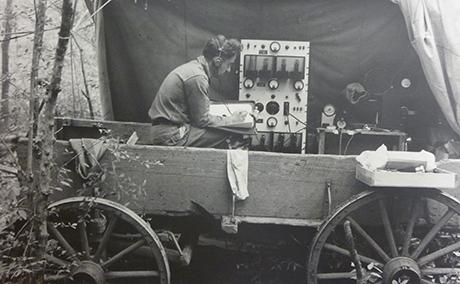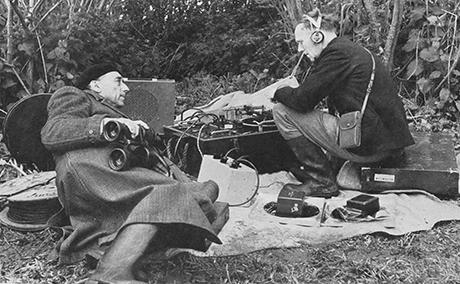Chip-chip-chip-chwee-chwee-tissi-chooeeo! These nonsense syllables have traditionally been used to capture the simple Chaffinch song, often to the despair of both novice birdwatchers and expert ornithologists. It’s not to be confused with the Song Thrush’s Chippoo-it tio-tew tutee-o wee-ploo-ploo tu-itty. “Each bird sings its own song,” a well-worn cliché advises, and since the late nineteenth-century, birders, naturalists, and biologists have sought to describe those songs to answer fundamental questions about animal communication, behavior, and evolution. But this scientific curiosity long preceded actual agreement on how to capture and study their notoriously fleeting impressions with satisfactory accuracy.
My current book project traces a history of sound recording in the field and its transformation into a scientific practice of studying the biological world. Surveying a history that leads past such settings as the Cornell University Laboratory of Ornithology, the British Broadcasting Corporation (BBC) and Cambridge University’s Department of Zoology as well as public parks, zoological gardens, and remote field sites between the 1880s to 1980s, it examines how field ornithologists, ethologists, and bio-acousticians legitimated their use of new media technologies as ways of sharing and representing sound; how they ordered such ephemeral vocalizations into objects of scientific investigation; and how this has changed what it means to listen to the natural world, for both scientists and their audiences at large. These questions feed into the Research Group “Epistemes of Modern Acoustics’” double concern with the cultural and material practices that prompted new insights into the nature and perception of sound and the role of sonic strategies in the production of scientific knowledge.
The recording and study of animal sounds was never an exclusively scientific affair. Virtually ubiquitous and traditionally understood as “song,” birds’ melodic vocalizations captivated a wide audience. As a result, techniques of field recording were often developed in close collaboration with a colorful parade of amateur naturalists, birdwatchers, sound hunting hobbyists, recording engineers, public broadcasters, instrument manufacturers, and musicians. But as scientists appropriated sound recording techniques from domains of music or broadcasting, the skills, meanings, and audiences associated with them also shaped the dynamics of knowledge production.
In the 1910s, amateur naturalists and professional ornithologists promoted musical notation as a precise and scientific technique for capturing and comparing birdsongs. Musical notation, they argued, provided scientific listeners with a technical idiom and systematic technique of the professional listener. But their notations also shared a cultural and textual domain with the musical scores circulating in high and low culture, produced by contemporary composers, nature-study pedagogs, and whistling bird imitators. This clouded the scientific status of their recordings, but also fuelled a debate on the musical, expressive, and behavioral nature of birdsong.

Fig. 2: Cornell ornithologist Peter P. Kellogg in an improvised studio on field expedition in 1935. Albert R. Brand Papers #21-18-899, Division of Rare and Manuscript Collections, Carl A. Kroch Library, Cornell University.
By the 1930s, the entertainment and recording industry enlisted scientists (such as the ethologist Oscar Heinroth, Berlin zookeeper Lutz Heck, or science popularizer Julian Huxley) to aid in recording bird vocalizations. Their work was used as a soundtrack in movie productions, in radio broadcasts, and as material for popular sound books and gramophone releases. In the United States, Cornell ornithologists learned to record nature sounds in collaboration with a movie production company. As field recordists learned to use gramophone cutters and electric microphones, however, they had to balance studio engineers’ notions of sound fidelity and an aesthetic of a noiseless and focused sound with their own concern for authenticity and objectivity.
Such collaborations continued in the 1950s, when the BBC made its archive of recordings –most of it recorded for program use by public broadcasting icon Ludwig Koch – available to scientists at naturalist organizations and academic institutes. At the Cambridge University Department of Zoology, these recordings were used as a basis for a new research program on birdsong learning under the direction of ethologist William H. Thorpe. These recordings’ wide appeal in scientific research and its popularization, for commercial entertainment and education, structured how they were produced, shared, and used. At the Laboratory of Ornithology, for instance, Cornell ornithologists sustained its bioacoustics program and Macaulay Library of natural sounds financially by capitalizing on their recordings and those of their amateur contributors through a sophisticated trade in recordings, involving cunning record swaps, copyright licensing, or the publishing of commercial LPs. Doing so required ornithologists to negotiate with their amateur and commercial collaborators on diverse forms of access, recognition, remuneration, and ownership.

Fig. 3: Nature recordist and radio personality Ludwig Koch (left) lying in wait around an improvised recording studio. From Koch (1955), Memoirs of a Birdman. London: Phoenix House.
Such recording practices, in turn, induced particular ways of listening to nature. In the early 1950s, bioacousticians redesigned the sound spectrograph from a wartime cryptoanalytic instrument into a tool for representing and analyzing birdsong. The sound spectrograph represented short sound fragments by means of a detailed acoustic spectrum analysis that, analysts claimed, allowed objective measurement. However, trained listeners remained important to sort through and categorize the hundreds of recordings that were collected in the field. Bioacousticians learned to listen, moreover, for brief, analyzable birdsongs that displayed remarkable geographic and temporal variations. Such songs displayed well, and provided them a window into learning mechanisms. In so focusing on such brief song excerpts against a noiseless background, however, scientists learned to disregard species whose songs included elongated and detailed duets or the influence of an acoustic environment on the formation of song for the next decades. The analysis carried out in this study reminds us that the historical contingencies of the cultural conditions under which scientific techniques develop shape the ways in which we come to hear the world.
This project is conducted within the research group “Epistemes of Modern Acoustics” of the Max Planck Institute for the History of Science, led by Viktoria Tkaczyk. The project forms the basis for two of its working groups: for “Testing Hearing: Science, Art, Industry,” it figures in a history of animal hearing research and its application in repellant technologies, and for “Sound Objects in Transition: Knowledge, Science, Heritage” it feeds a longue durée perspective on the instruments, models, and metaphors that have helped scientists to investigate and think about the avian voice and the mechanism of its syrinx.
